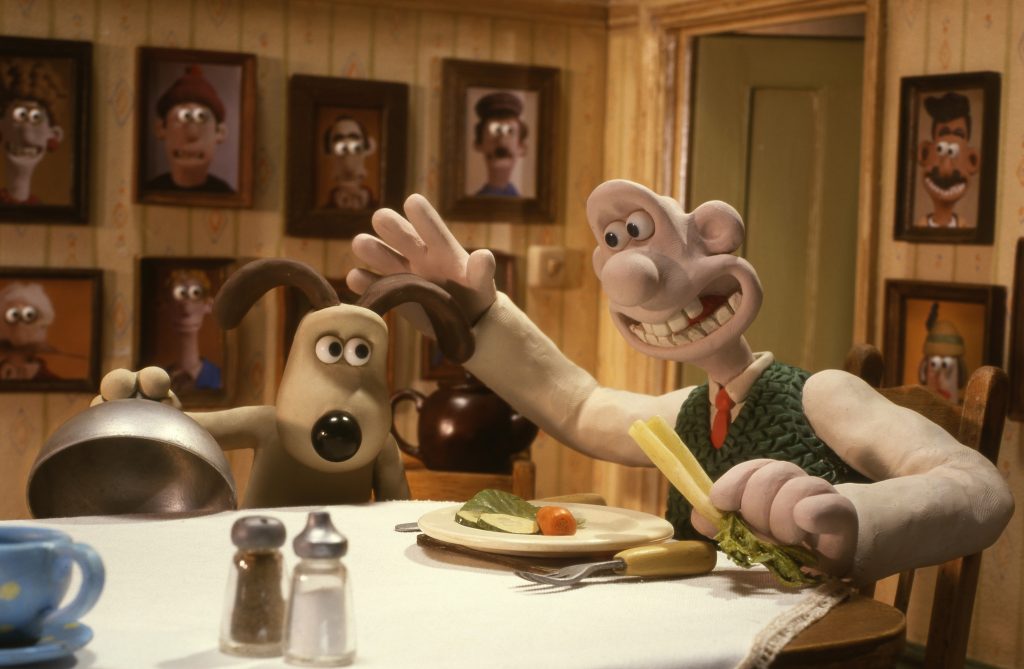In October 2005, two different stop motion animated films opened in American cinemas. And while Corpse Bride may have gotten more headlines on account of being a (then-lucrative) Tim Burton – Johnny Depp team-up, in the end it was Wallace & Gromit: The Curse of the Were-Rabbit that truly won the hearts of audiences (and the Oscar). To this day, it remains the second highest-grossing stop motion film of all time, behind fellow Aardman production Chicken Run.
This shouldn’t come as a surprise, given the enduring popularity of the duo created by British animator Nick Park: eccentric inventor Wallace (voiced by Peter Sallis) and his loyal dog Gromit (who never speaks). First introduced in 1989’s A Grand Day Out, they gained even more recognition with the follow-up shorts The Wrong Trousers (1993) and A Close Shave (1995), both of which won the Academy Award in the relevant category (amusingly, A Grand Day Out lost to Creature Comforts, also directed by Park). In their native UK, they’re so iconic that the TV airings of their adventures come with custom-made BBC idents featuring the pair.
Of course, by the time the feature film entered production, there had been a major change: while Aardman Animation remained firmly in control on the creative side, distribution was to be handled by DreamWorks, whose then-CEO Jeffrey Katzenberg had a very different vision of what audiences wanted from animation (for context, the studio’s in-house production that year was Madagascar). While neither party has ever openly acknowledged it, odds are Katzenberg was not too fond of the idea of Wallace being voiced by an actor who was virtually unknown outside of Britain.
Presumably as a compromise, Helena Bonham Carter and Ralph Fiennes were cast in key supporting roles (respectively as the love interest and antagonist), a marked departure from the franchise’s distinctly Northern charm: the setting – occasionally identified as Wigan in Greater Manchester – is based on Park’s childhood growing up in Lancashire, and the characters usually speak with the appropriate regional accent (although Wallace’s characterization is more Yorkshire, similar to the voice Sallis used for his role in the sitcom Last of the Summer Wine).
In fact, the local quality is what has made Wallace and Gromit so instantly recognizable over the years, but that didn’t stop DreamWorks from trying to make sure the film would appeal to a wider audience. Some requests, most notably changing the title from The Great Vegetable Plot to The Curse of the Were-Rabbit, were deemed reasonable enough. Others, like supposedly making the designs more palatable to modern American viewers, much less so.
Park stuck to his guns, for the most part, leading to a falling out with DreamWorks that caused the American studio to part ways with Aardman after the third and final film produced under their agreement, 2006’s Flushed Away, flopped at the box office (The Curse of the Were-Rabbit was also a bit of a disappointment in the US, although it grossed $192 million worldwide on a $30 million budget). Not that the Bristol-based stop motion company was too broken up about it: while promoting 2008’s A Matter of Loaf and Death, a return to the half-hour format for Wallace and Gromit, Park commented: “I don’t feel like I’m making a film for a kid in some suburb of America – and being told they’re not going to understand a joke, or a northern saying.”
While the experience may have soured Park on working in the feature-length format for a few years, it didn’t really affect the quality of the film itself. From the opening sequence, which silently recaps Wallace and Gromit’s friendship to the tune of Julian Nott’s classic theme, it’s clear the characters are just as we remembered them, ready to embark on a new adventure featuring cheese, thrilling chase scenes, impeccable banter and exquisite puns (including some of the cleverest naughty jokes ever written for a G-rated project). Sure, one wonders if Gromit attending Dogwarts University was a Park original or an American suggestion, but that gag still works in the context of a franchise that consistently delights in wordplay based on famous works of literature.
Aardman went on to partner with Sony/Columbia for its next two releases, and while there was a fair amount of celebrity voice casting in those films, they still retained their British quirkiness (and in the case of Hugh Grant as the Pirate Captain, the actor deliberately deviated from his usual speech patterns, to the point even his own children didn’t realize it was him at first). Most recently, their output has been distributed by Netflix, including a new feature starring the inventor and his dog: Vengeance Most Fowl.
Ironically, despite being on a platform with a reputation for generic productions, that film – a sequel to The Wrong Trousers – doubles down on the characteristics that Katzenberg supposedly didn’t care for, culminating in a much celebrated sight gag about the rivalry between Yorkshire and Lancashire. And while Peter Sallis died in 2017, no stunt casting occurred with the role of Wallace, currently voiced by Sallis’ understudy and successor Ben Whitehead, still sounding exactly the same. As the cheese-loving inventor himself might say: “Cracking voice, Gromit!”
“Wallace & Gromit: The Curse of the Were-Rabbit” is available for digital rental or purchase.

